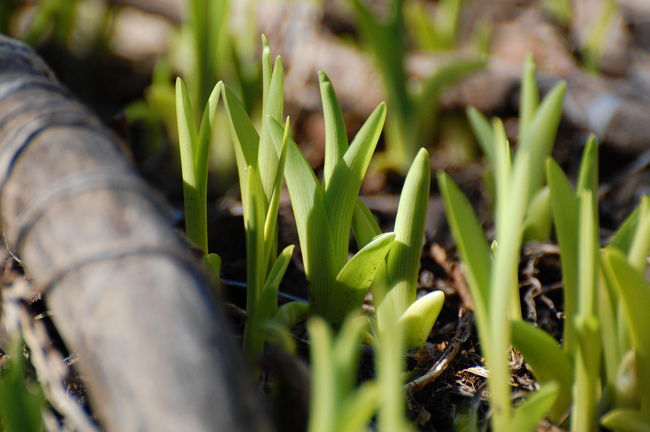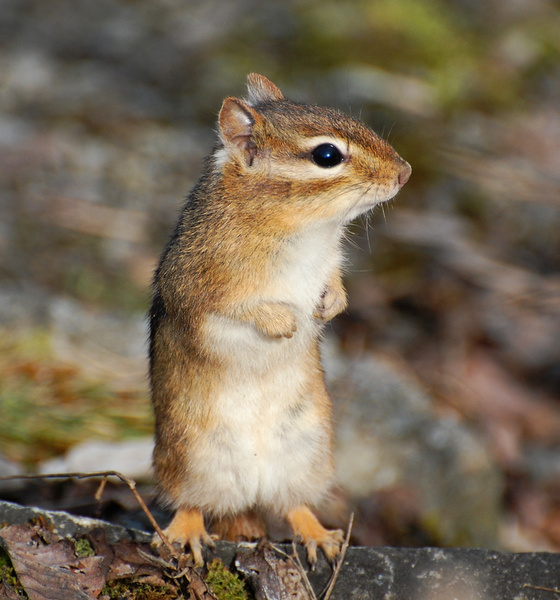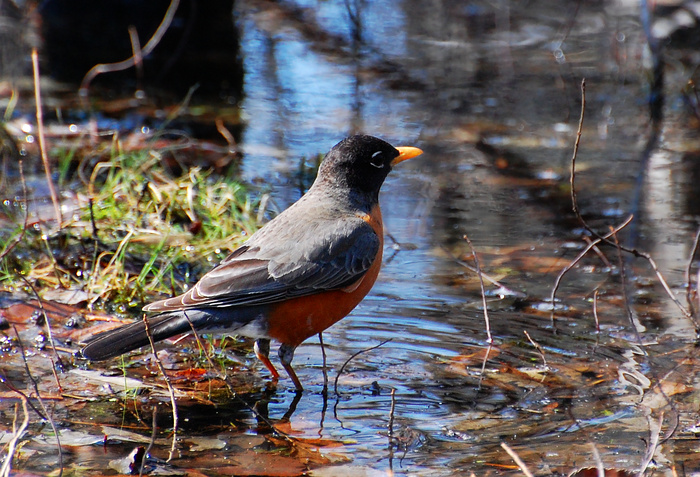
A scoundrel of a bird
April 16th, 2009
I found another singing Brown-Headed Cowbird at Fletcher Wildlife Garden, this time in their backyard garden and with camera in hand (me, not the bird.)

1680x1050 wallpaper
"By human standards, the female cowbird is not only a born sneak but a shiftless parasite as well. She builds no nest of her own but goes snooping about the shrubbery until she locates one of another bird smaller and weaker than herself; she lays her egg in it and goes merrily on her way, never bothering to call around to see how her offspring is faring under the care of its foster parents. And how does it get along? It gets along far too well, for being larger than its fellow nestlings it gluttonously grabs most of the food brought by the victimized parents. Because of its unfair advantage, the baby cowbird is sometimes the only nestling to survive, the weaker ones being suffocated or pushed out of the nest as the little monster gradually takes over the entire space."
- http://museum.gov.ns.ca/mnh/nature/nsbirds/bns0396.htm
There is also such a thing as a cowbird mafia. Naturalists have observed cases where a female will return to where she laid her egg. If the egg is still there, all is well. If it isn't, she trashes the nest.
Dastardly birds, really. But pretty.
Love And War
April 14th, 2009
'Tis the season to see interesting water birds at Dow's Lake. Common Mergansers all over the place, a few Hooded Mergansers, and a lone Double-Crested Cormorant sunning on a rock. Over at Fletcher Wildlife Garden, a male Brown-Headed Cowbird was singing at the edge of a field.
Some trivia:
- Mergansers: fish-eating diving ducks. ("Diving ducks" are ducks who
submerge all the way underwater when feeding.) All female mergansers have
shaggy orangeish-brown crests.
- Cormorants: Odd, rather prehistoric-looking black water birds, related to
pelicans. Unlike most water birds, their wings aren't waterproof, so they have
to stand in the sun and dry them off periodically.
- Brown-Headed Cowbird: A small blackbird that lays its eggs in other birds' nests. The hosts then raise the young, sometimes at the expense of their own chicks, unless they're smart enough to evict the foreign eggs on sight. Historically Cowbirds followed the movements of bison, which is why they didn't have time to nest on their own.
Finally I found the culprit: a lone female Red-Winged Blackbird. She flew off, pursued by nearly every male in sight, and took shelter in some underbrush at the marsh edge, flicking her tail and looking only mildly perturbed.
Coming soon: baby Red-Winged Blackbirds!
Bookends
April 12th, 2009
There was something magical about the light on Friday afternoon. Everything seemed luminous. I found myself trying for shots that I wouldn't normally do: leaves, moss, bare branches on blue sky. Even an old stump caught my attention.
These two came out especially well, and they bookend nicely: last year's leaves, and this year's spring shoots. The second picture was taken right next to the Britannia Yacht Club, thus the old twine on the log.


Great Blue On The Prowl
April 10th, 2009
Birding out at Mud Lake today, and it never rains but it pours! Lots of interesting sightings and three spring firsts: Tree Swallows, Scaup, and a Great Blue Heron fishing on the Ottawa River.
Tree Swallows are beautiful, graceful, streamlined birds who are nearly impossible to photograph unless you catch them nesting, because they seldom perch any other time. Scaup are nearly as difficult because they like to stay way out in the water. But Great Blue Herons: them I can handle. Big, bold and photogenic.

1680x1050 wallpaper

Whazzat?
April 8th, 2009

1680x1050 wallpaper
And miles to go before I sleep
April 5th, 2009
Hiking at Jack Pine Trail with some friends today. About 13 kilometers (8 miles), the farthest I've ever gone by foot. Numerous parts of my body are complaining, but at least they seem to be going in rotation rather than all at once. Right now it's my shins. They inform me that hiking 13 kilometers in tall boots was not a happy thing for them.
For the most part it wasn't very birdy, but there were a few pleasant surprises:
- A remarkably tame Ruffed Grouse. He came out of the bushes and right up to our feet looking for handouts, clucking softly. I'd seen these birds at a distance in the shadows at Old Quarry Trail, and thought them plain and rather dumpy. Up close I was surprised at how handsome and, well, graceful he was (at least for a game bird). I almost didn't believe he was really a Ruffed Grouse, but there was no other option.
No camera on hand, alas. If I'd had my camera, it would have for once been a question of, "will this bird stay far enough away for me to shoot him, or will I wish I'd brought the regular lens?" He was that tame.
- A singing American Tree Sparrow by a marsh. I've logged thirteen sightings of this species so far, but this is the first time I've ever found one singing, so that was a treat. They don't breed here though. They winter here. They'll sing just a little while longer and then head back to the far north.
- A set of feeders attracted huge, noisy flocks of Pine Siskins and Slate-Colored Juncos, along with the omnipresent chickadees and a few woodpeckers. A small Bohemian Waxwing flock stopped by too. For someone in love with birds as I am, it was enough to leave me standing there looking around with my mouth hanging open like a fool for a good twenty minutes.
The Lookout
April 4th, 2009

This was taken back in early March when the Canada Geese first started trickling in. A simple picture, but I found it evocative.
Exercise in self-torture, take two
April 2nd, 2009
For those of you who weren't with me last fall, let me describe the exercise in self-torture:
It starts when you discover a migrant flock of Golden-Crowned Kinglets, very tiny, very cute birds with the activity level of chickadees on crack. The females have a bright yellow crown stripe. The males have an even brighter yellow crown stripe, plus a central stripe of the most beautiful vivid orange--but that part's usually hidden. He has to ruffle his crown feathers for you to see it.
You, the aspiring nature photographer, would like to get a half-decent picture of one of them, sitting still, in good light, with the golden crown visible. If you're really wishing, you'd like to catch a male showing off his orange. When you stand and watch these birds with binoculars you see them in all sorts of fetching poses, flashing their crowns every few seconds, so it seems a reasonable thing to wish for.
What you actually get is: smudgy distant photos, motion-blurred photos (lots of those), shadowed photos (because you tracked them into some dense thicket and there's not enough sun getting through), nice well-focused photos with no golden crowns visible, and photos with nothing in them, because the bird flew out of frame before you could push the button. You're there for hours. Every fifteen minutes or so, the whole flock suddenly disappears and goes you know not where. (Their voices are so soft that it is impossible to follow them by sound.) Fifteen minutes later they show up again, and you get another batch of bad pictures.
Finally, your patience gone, your morale shot, you're just about to throw in the towel, and then a Golden-Crowned Kinglet alights on a branch six feet away from you and just sits there. He tilts his head and shows off his crown. You lift the camera, focus, click, and by god, he sat still the whole time. Then you look at the picture on the LCD...and it's dark. It's blurry. The lighting was no good. You know why? Because you've been out here so long, trying to photograph these damn birds, that the sun set an hour ago.
At this point you smash your $600 zoom lens with a sledgehammer and go off to take up a more satisfying hobby, like stamp collecting.
Take two. The good news is, it's early April. These guys have made a long trip from as far south as Mexico and most of them have further to go yet. They're tired, perhaps finding it a little colder than they'd like, and they aren't doing much flycatching because there are few flying insects to speak of. This all means that their activity level is more of a "chickadee on espresso" than chickadee on crack. So while it was still an exercise in self-torture, it wasn't a complete loss.



This is somewhat of a turning point. It was kinglet season back when I first bought my new lens in autumn. Bird migration follows a "last in first out" rule, which means that the species still to come (of which there are tons) will be, for the most part, species I have never before had the chance to photograph. Exciting!
Wetland Robin
April 1st, 2009

1680x1050 wallpaper
The Project
March 29th, 2009
I watched for some time as this Blue Jay poked, prodded, fussed and fiddled with what looked like an old leaf. Only when I studied the pictures back home did I realize it wasn't a leaf, though I'm still not sure what it was. Cocoon, maybe?

1680x1050 wallpaper
Blue Jays can be so gorgeous, it's hard to believe that they have no blue pigment in their plumage at all. But it's true: the color is caused by the structure of the feathers and the way light refracts through them. In other words, if you grind up a Blue Jay feather, it won't be blue anymore.
|
